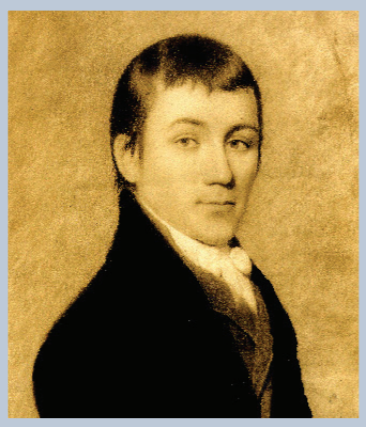3.18: Charles Brockden Brown (1771–1810)
- Page ID
- 57460
Charles Brockden Brown was born into a Quaker family in Philadelphia. He studied at the Friends Latin School in Philadelphia then learned law in a Philadelphia law office. However, he turned away from the practice of law due to moral repugnance and focused instead on making a living as a writer. He had literary ambitions from his youth onwards, including projecting poems on explorers of the New World.

Image \(\PageIndex{1}\): Charles Brockden Brown
He found inspiration for writing through a circle of friends in New York City, where he lived from the 1790s onward. These friends included Timothy Dwight (1752–1817), a future president of Yale, and Noah Webster (1758– 1843), the lexicographer. Brown was also influenced by the shift from the Age of Reason to early Romanticism occurring with contemporary British authors, particularly William Godwin (1756–1836), a radical political philosopher and Gothic novelist, and Mary Wollstonecraft (1759–1797), a women’s rights advocate, novelist, and historian. The latter’s influence appears in Brown’s Alcuin; a dialogue (1798) which advocated women’s equality and place in the public sphere, rather than only the domestic or private sphere. Godwin’s influence may appear in the Gothic bent of Brown’s work, which, though grounded in concrete reality, expands into Gothic extravagance and the irrational.
Starting in 1798, Brown published seven novels in four years, the most wellknown of these being Weiland, a fictionalization of an actual Pennsylvania murder case. These works use American settings, stories, and events, including Native Americans, the American frontier, and a yellow fever epidemic in Philadelphia. They also include the uncanny, the mysterious, the psychotic, and the unconscious (or a mind not at one with itself). The titular character of The Memoirs of Carwin the Biloquist, for example, uses ventriloquism to suggest supernatural visitations of the dead. Brown thus serves as forerunner for Edgar Allen Poe, Nathaniel Hawthorne, and Herman Melville.
Brown relied for a living more pragmatically on journalistic writing, editing The Monthly Magazine and American Review (1799–1800), The Literary Magazine and American Register (1803–1807), and The American Register and General Repository of History, Politics, and Science (1807–1810).

